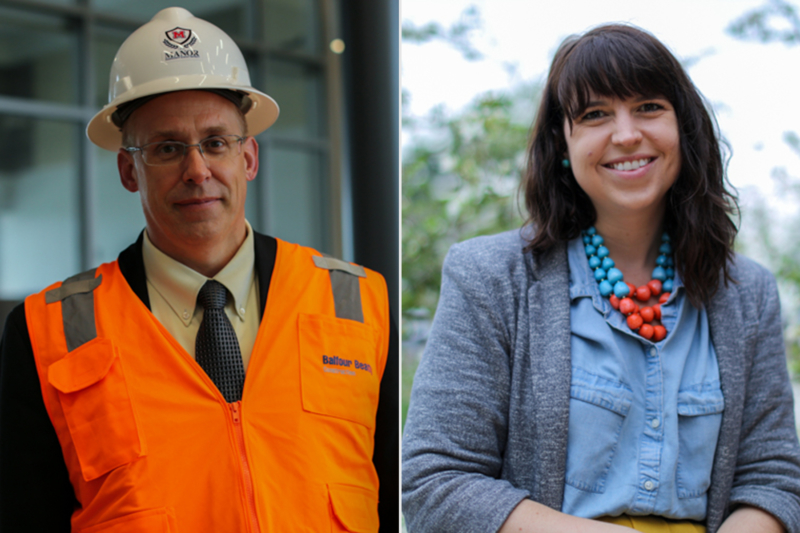Architects: Hardening Schools Won’t Solve School Shootings
By Carlos Anchondo
Reporting Texas

Michael Brooks, left, executive director of facilities and construction management at the Manor school district, in front of the new Manor Senior High School slated to open in August. As an education planner, Raechel French, right, bridges architectural design with the needs of K-12 learning environments. Photos by Adrienne Pond/Reporting Texas
A familiar pattern has emerged in the aftermath of the school shooting in Parkland, Florida. Politicians offer thoughts and prayers. Activists and survivors clamor for stricter gun control. The shooter’s mental health and background is scrutinized.
More recently, calls arose to “harden” schools against potential intruders. One week after the Parkland shooting on Feb. 14, President Donald J. Trump said, “We have to harden our schools, not soften them up.” What hardening means – interpretations range from arming teachers to perimeter fencing – remains unsettled.
Yet for many in architectural design, the idea of hardening schools is antithetical to creating the best possible learning environment. And, they say, while the threat of an active shooter has influenced the work of school architects, added design features can only do so much to deter violence.
Chris Gibbs, a principal with the DLR Group, a national architectural firm known as a leader in school design, called the school shooting situation “heartbreaking.” Gibbs, who is based in Minneapolis, believes hardening schools into bunkers is the wrong approach, though.
“The reality is that design features can only go so far and are a small part of the overall solution,” Gibbs said. “It is a part of our role and part of our obligation to create safe environments for our clients, but even if you harden a building as much as you can, there’s still going to be tragedies if we don’t deal with some of the core issues behind them.”
Largely since the Columbine High School shooting in 1999, architects have incorporated specific design features to make campuses more secure. Schools are now built with an entrance vestibule, which controls the flow of visitors through a centralized entry point. Alcoves have made way for streamlined halls, which give teachers and administrators the best line of sight during a crisis. Buildings are set back from the street and surrounded by a fence. Security cameras are ubiquitous.
Approaches like CPTED, or crime prevention through environmental design, provide architects with basic strategies and design features to help stop criminal activity before it happens. The CPTED concept evolved out of the criminology field and its strategies focus on the built environment.
Still, even with more security measures in place, massacres continue to occur. In 2018 alone, 17 school shootings in the U.S. have taken place where individuals were killed or injured.
Shooters often know someone at the school or are students themselves. Shooter Adam Lanza used an AR-15 to shoot his way into Sandy Hook Elementary in 2012, despite the locked front doors and a school security system. He killed 20 children and six staff.
At Parkland’s Marjory Stoneman Douglas High School, Nikolas Cruz walked through an open security gate before entering a building, ultimately killing 14 students and three staff and wounding others.
Once used by military and defense experts to describe protective measures to keep facilities like airports and nuclear reactors safe from terrorist attacks, the term hardening has new meaning as the reality of school shootings persists. Since the Sandy Hook shootings, the National Rifle Association has advocated for hardening schools against intruders. After Parkland, NRA head Wayne LaPierre has reiterated this position.
“The hardening of facilities is primarily a tactic to buy time, to slow down a perpetrator and give responders a chance to react,” said Sean Connor, a partner at Pfluger Architects, an educational architecture firm in Austin. “The best safeguard is a campus culture that fosters communications and relationships of trust between staff and students.”
Manor Senior High School, set to open in August, was designed to have the look and feel of a small college campus. Located in a suburb northeast of Austin, the school has both traditional classrooms, where students sit at desks facing a teacher, and outdoor spaces where students can do experiments and learn in less formal surroundings. It was planned with many of the most current architectural safety features. The $48 million school has a 1,200-student capacity.
Video systems monitor all access points on the new campus. Long, straight hallways have no hidden entrances. All visitors are buzzed in through a central vestibule, which could be locked down in the event of an active shooter.
“Schools need to be warm, inviting and instructional environments to be successful,” said Michael Brooks, executive director of facilities and construction management with the Manor school district. “Everyone is cognizant of what has happened in other schools, so we are taking steps to make things safer, so our students can focus on learning and our teachers on teaching.”
Among other features, bullet-resistant film is being applied to windows at Manor Senior High School, and plans are in the works to retrofit windows at Manor New Tech Middle School and nine elementary schools within the district.
Gone are the days when schools were erected with neoclassical facades and utilitarian, box-like classrooms. Today, schools are built to prioritize the physical and mental well-being of students and teachers and to embrace the latest technological advances.
With more than 130,000 educational institutions nationwide, both public and private, employing design to deter shootings is likely to be a long, slow process.
“You can provide a very safe and secure setting without a hard-shell, prison-like atmosphere,” says Raechel French, an Austin-based associate with the DLR Group. “You can’t plan for every event, so it’s doing the best we can without sacrificing the learning environment. Because that’s really what’s important.”